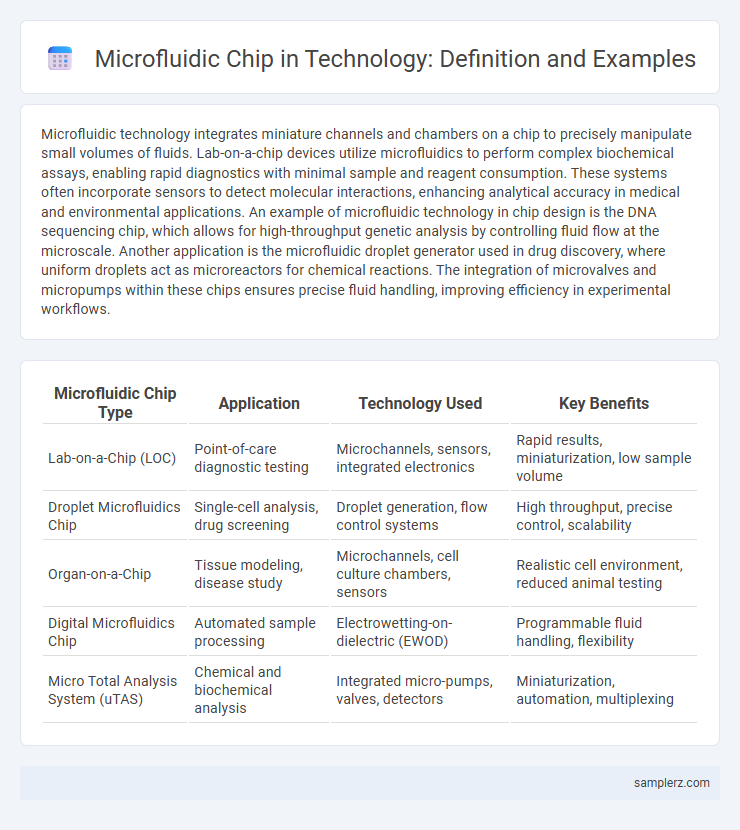Microfluidic technology integrates miniature channels and chambers on a chip to precisely manipulate small volumes of fluids. Lab-on-a-chip devices utilize microfluidics to perform complex biochemical assays, enabling rapid diagnostics with minimal sample and reagent consumption. These systems often incorporate sensors to detect molecular interactions, enhancing analytical accuracy in medical and environmental applications. An example of microfluidic technology in chip design is the DNA sequencing chip, which allows for high-throughput genetic analysis by controlling fluid flow at the microscale. Another application is the microfluidic droplet generator used in drug discovery, where uniform droplets act as microreactors for chemical reactions. The integration of microvalves and micropumps within these chips ensures precise fluid handling, improving efficiency in experimental workflows.
Table of Comparison
| Microfluidic Chip Type | Application | Technology Used | Key Benefits |
|---|---|---|---|
| Lab-on-a-Chip (LOC) | Point-of-care diagnostic testing | Microchannels, sensors, integrated electronics | Rapid results, miniaturization, low sample volume |
| Droplet Microfluidics Chip | Single-cell analysis, drug screening | Droplet generation, flow control systems | High throughput, precise control, scalability |
| Organ-on-a-Chip | Tissue modeling, disease study | Microchannels, cell culture chambers, sensors | Realistic cell environment, reduced animal testing |
| Digital Microfluidics Chip | Automated sample processing | Electrowetting-on-dielectric (EWOD) | Programmable fluid handling, flexibility |
| Micro Total Analysis System (uTAS) | Chemical and biochemical analysis | Integrated micro-pumps, valves, detectors | Miniaturization, automation, multiplexing |
Introduction to Microfluidic Chips: A Technological Breakthrough
Microfluidic chips revolutionize technology by enabling precise manipulation of fluids at the microscale, facilitating rapid biochemical analyses and medical diagnostics. These chips integrate microchannels fabricated using techniques like photolithography and soft lithography, allowing efficient sample handling with minimal reagent consumption. Their applications span drug development, point-of-care testing, and environmental monitoring, highlighting their transformative impact on lab-on-a-chip systems.
Lab-on-a-Chip: Revolutionizing Diagnostics Through Microfluidics
Lab-on-a-Chip technology integrates microfluidic channels and sensors onto a single microchip, enabling rapid and accurate medical diagnostics with minimal sample volumes. This innovation facilitates point-of-care testing for diseases such as cancer, infectious pathogens, and cardiovascular conditions by automating complex laboratory functions on a handheld device. Microfluidic Lab-on-a-Chip systems enhance sensitivity and reduce costs, driving advanced personalized medicine and real-time health monitoring.
Point-of-Care Testing Devices Using Microfluidic Chips
Microfluidic chips revolutionize point-of-care testing devices by enabling rapid, accurate diagnostics with minimal sample volumes. These chips integrate channels and sensors at the microscale, facilitating real-time analysis of blood, saliva, or urine for diseases like diabetes and infectious infections. Enhanced sensitivity and portability of microfluidic point-of-care devices accelerate clinical decision-making and improve patient outcomes.
Microfluidics in DNA Sequencing and Genetic Analysis
Microfluidics technology enables precise manipulation of minute fluid volumes within microchips, revolutionizing DNA sequencing and genetic analysis by enhancing speed, accuracy, and cost-efficiency. Integrated microfluidic chips facilitate rapid sample preparation, amplification, and sequencing processes by automating complex workflows and minimizing reagent consumption. This innovation accelerates personalized medicine, gene expression profiling, and single-cell genomics by providing high-throughput, scalable platforms for detailed genetic insights.
Drug Development and Screening on Microfluidic Platforms
Microfluidic platforms enable precise manipulation of nanoliter-scale fluid volumes, accelerating drug development by replicating physiological conditions and enhancing high-throughput screening accuracy. These chips facilitate simultaneous testing of multiple drug candidates on cultured cells or organoids, dramatically reducing time and cost compared to traditional methods. Integration of real-time analytical sensors on microfluidic devices improves the monitoring of drug responses and toxicity, making them indispensable tools for personalized medicine and pharmaceutical research.
Microfluidic Chips in Environmental Monitoring Solutions
Microfluidic chips enhance environmental monitoring by enabling precise analysis of water pollutants and airborne toxins at microscale levels. These chips integrate sensors and fluid channels to rapidly detect contaminants like heavy metals and pathogens, offering real-time data with high sensitivity. Their portability and low reagent consumption make them ideal for field applications in environmental surveillance and pollution control.
3D Cell Culture and Organ-on-a-Chip Technologies
Microfluidic chips enable precise 3D cell culture by replicating physiological conditions through controlled fluid flow and spatial organization, enhancing tissue engineering and drug testing accuracy. Organ-on-a-chip technologies integrate microfluidic channels with living cells to simulate organ-level functions, providing advanced models for disease study and personalized medicine. These platforms improve experimental throughput and reduce reliance on animal models in biomedical research.
Advances in Microfluidic Chip Fabrication and Materials
Recent advances in microfluidic chip fabrication leverage novel materials such as polydimethylsiloxane (PDMS), cyclic olefin copolymer (COC), and glass to enhance biocompatibility and chemical resistance. Techniques like soft lithography, injection molding, and 3D printing enable precise control over microchannel dimensions, improving fluid manipulation at the microscale. Integration of sensors and actuators within these chips facilitates real-time monitoring and complex biological analyses, advancing applications in diagnostics and drug development.
Integration of Microfluidics with Biosensors for Real-Time Analysis
Integration of microfluidics with biosensors enables real-time analysis by allowing precise control and manipulation of minute fluid volumes on a chip, enhancing sensitivity and speed. Examples include lab-on-a-chip devices used for rapid disease diagnostics, where microchannels direct biological samples to embedded sensors for instant detection of biomolecules. This synergy improves accuracy in monitoring glucose levels, detecting pathogens, and performing environmental analysis, revolutionizing point-of-care testing.
Future Trends and Applications of Microfluidic Chip Technologies
Microfluidic chip technologies are rapidly advancing with future trends emphasizing integration with artificial intelligence and IoT for real-time data analysis and personalized healthcare. Emerging applications include point-of-care diagnostics, drug delivery systems, and lab-on-a-chip devices capable of automated biochemical assays. Innovations in materials and fabrication techniques are enabling higher sensitivity and multifunctionality in microfluidic platforms, driving their adoption in clinical and environmental monitoring.

example of microfluidic in chip Infographic
 samplerz.com
samplerz.com